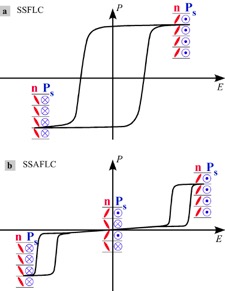Ferro- and antiferroelectric liquid crystals
If a smectic liquid crystal with tilted molecules (smectic-C-type phase) is made chiral, the reduced symmetry leads to the appearance of a spontaneous polarization directed perpendicular to the plane spanned by the smectic layer normal and tilt direction. Macroscopically, a bulk liquid crystal of this type still shows no net polarization, because the chirality also leads to a helical modulation of the tilt direction, and thus of the polarization. This cancels out the polarization on the scale of a micron or so in this helical antiferroelectric configuration, and all chiral smectic-C-type liquid crystals are thus naturally antiferroelectric. However, by enclosing them between closely spaced substrates that impose planar alignment, the helix can be unwound, and then they can develop ferroelectric behavior. There is then a unidirectional spontaneous polarization over macroscopic areas, directed either up or down with respect to the sample plane, and the direction can be switched by application of an electric field stronger than the coercive threshold. The effect is called surface-stabilized ferroelectricity and you can read about it in the classic paper by the discoverers.
Ferroelectric and antiferroelectric liquid crystals (FLCs and AFLCs, respectively) have characteristic responses to applied electric fields, with two and three distinct states, as illustrated in the figure to the right. In case of FLCs both switched states are stable in the absence of field, whereas AFLCs are monostable.
Jan has a long tradition of studying ferro- and antiferroelectric liquid crystals, since his doctoral studies time. Currently we are working on rather small scale with FLCs, in the context of their response to relevant non-liquid crystalline systems, as well as how they behave in shell and fiber geometry. Hopefully we will soon be able to write more about it here. In the meantime, some key publications on the earlier work are the following:
- Current topics in smectic liquid crystal research (Review article)
Jan P. F. Lagerwall, Frank Giesselmann
ChemPhysChem, 7, 1, pp. 20-45 (2006) - Demonstration of the antiferroelectric aspect of the helical superstructures in
Sm-C*, Sm-Cα* and Sm-Ca* liquid crystals
Jan P. F. Lagerwall
Phys. Rev. E, 71, pp. 051703 (2005) - A chameleon chiral polar liquid crystal: rod-shaped when nematic, bent-shaped when smectic
Jan P. F. Lagerwall, Frank Giesselmann, Michael D. Wand and David M. Walba
Chem. Mater. 16, 19, pp. 3606 - 3615 (2004) - Frustration between syn- and anticlinicity in mixtures of chiral and non-chiral tilted smectic-C-type liquid crystals
Jan P. F. Lagerwall, Gerd Heppke, Frank Giesselmann
Eur. Phys. J. E 18, 1, pp. 113-121 (2005)
- On the change in helix handedness at transitions between the Sm-C* and Sm-Ca* phases in chiral smectic liquid crystals
Jan P. F. Lagerwall, Frank Giesselmann, Mikhail A. Osipov
Liq. Cryst. 33, 6. pp. 625-633 (2006) - Ferroelectric polysiloxane liquid crystals with ’de Vries’-type smectic A* -smectic C* transitions
Martin Rößle, Rudolf Zentel, Jan Lagerwall and Frank Giesselmann
Liq. Cryst. (Preliminary Communication) 31, 6, pp. 883 - 887 (2004)
 Back to research overview.
Back to research overview.







